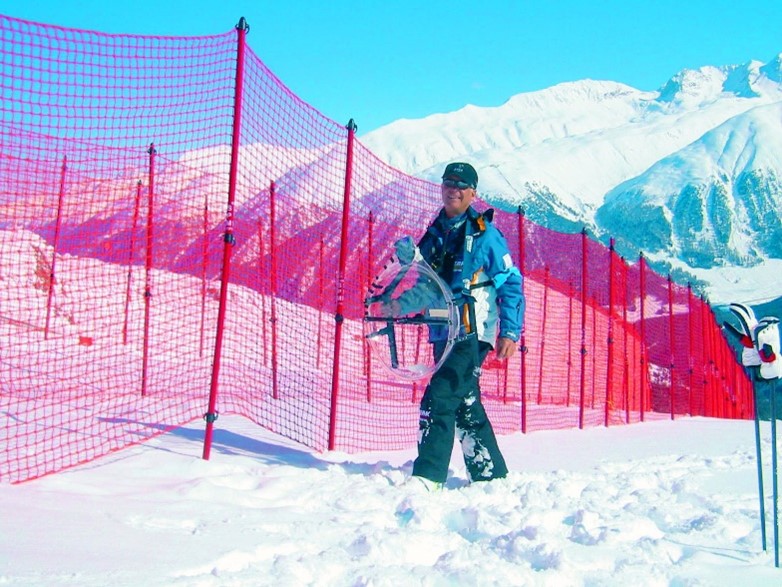The Sennheiser MKH 416 Shotgun Microphone Turns 50

Manfred Hibbing with the MKH 416. The photo was taken in 2023
One of Sennheiser's most revered microphones, the MKH 416 P48 shotgun microphone,
celebrates its
golden jubilee this year! For 50 years, the MKH 416 has accompanied broadcasters, filmmakers,
voice-over artists, and content creators; it has been used in studios and in the field. Mounted onto
a boom pole, a stand or a camera, its job has been to stay outside the camera angle while gracefully
capturing sound with clarity and impact.
To celebrate its golden jubilee, this classic mic is offered with a 25% anniversary discount across
distributers and also on Amazon, starting 10th April, till 31st May.
Time travelling to the 1970s
The name of Manfred Hibbing is firmly linked with this milestone product. When the young engineer
joined Sennheiser, his first task was to design the MKH 416 P48 based on the MKH 415
T. The MKH 416
was to be Sennheiser's first phantom-powered (P48) shotgun microphone, while all previous models
were AB-powered. In those days, AB powering was preferred in broadcast situations because of its
resistance to ripple voltages, but phantom powering had become established in the studio.
50 years old but always up to date
Hibbing's involvement was a stroke of luck for the MKH 416 RF condenser microphone, as he possessed
ample expertise both in electroacoustics and in RF technology. In an interview in 2023, he said that
optimising the interaction between the electroacoustic transducer and the electronic circuit had
been his favourite task in designing the 416.
The long lifespan of the MKH 416 P48 fills the engineer with pride: "During all this time, the
design of the MKH 416 was only revised in two instances: one was to make it suitable for SMD
mounting, and the other to update it for a more advanced transducer technology."
A standard in the studio and in the field - but why exactly?
One reason is that the MKH 416 operates on the RF condenser principle. In this context, RF (radio
frequency) has nothing to do with wireless, but rather refers to the high-frequency voltage at the
capsule and the associated electronics in the microphone. The huge advantage of this design is that
it makes the condenser microphone resistant to humidity. Unlike "standard" condenser microphones, RF
condenser models can be used outdoors, in hot and humid or cold and misty weather. MKH microphones
have reliably recorded audio in a wide variety of challenging locations, from deserts to the Arctic,
to rain forests.

RF condenser microphone used in outdoor broadcasting
Another reason for the success of the MKH 416 is in its excellent directivity, which is the result
of the acoustic interference principle on which it operates. The actual microphone capsule is
combined with a so-called interference tube in front of it. This tube has regularly arranged slots,
which are covered with fabric that has a certain acoustic impedance and prevents reflections and
standing waves inside the tube. If sound arrives directly from the front, the interference tube has
no effect at all. But when sound enters the tube from the sides, it passes through different holes.
This results in different path lengths to the transducer and thus different time delays. Depending
on the angle of sound incidence, the sound components more or less cancel each other out. This
effect increases at higher frequencies: Here, the microphone essentially picks up the sound coming
from the front. This is particularly important for speech intelligibility as the decisive speech
formants are recorded with less lateral interference at high frequencies than with standard
microphones.

The MKH 416 offers a perfect mix of directivity and climate-proof design
The longer the shotgun, the more this interference principle extends to lower frequencies.
Unfortunately, the longer length also makes the microphone more difficult to handle. The MKH 416 is
certainly so popular because, despite its short length, it offers an effective directionality. How
this particular length came about is its own story, and that takes us back to its predecessor, the
MKH 415 T.
The hacksaw and the microphone
In 1970, the newly designed MKH 415 shotgun microphone was the pride and joy of the Sennheiser
development engineers. It was less sensitive to wind and pop noise, had greater resistance to
handling noise, and excellent directivity. With the new microphone in his briefcase, an enthusiastic
Dr. Griese, Technical Manager at Sennheiser, went off to visit radio and TV broadcasters. The
customers showed a great deal of interest in the new shotgun microphone - but couldn't resist
picking at it. They complained that the shotgun effect was so strong that you had to keep moving the
microphone to follow the speaker around.

Dr. Griese, then Sennheiser's Technical Manager, was an engineering genius with a sense of humour
Dr. Griese listened to the comments for a while and then asked for a hacksaw. "How much directivity
would you like?" he asked the amazed observers. And without batting an eyelid he proceeded to saw
off a section of the microphone tube. The customers were stunned. Dr. Griese then tried out the
shortened microphone once again and, to everyone's amazement, it was perfect! From then on, the MKH
415 - and thus also the MKH 416 which followed its design - were highly successful as the preferred
microphone for vocalists, film teams and reporters, with the specialist media being equally
impressed by the "unusually short length" (Funkschau) of the shotgun mic.
Conclusion
"The MKH 416 continues to be a standout in our shotgun microphone range, even with the introduction
of newer models over the years," says Vipin Pungalia, Director - Pro Audio and Country Head,
Sennheiser India. "It's a legendary product in our portfolio-renowned for its versatility,
durability, and exceptional performance. The MKH 416 is one of those rare microphones that got
everything right from day one."